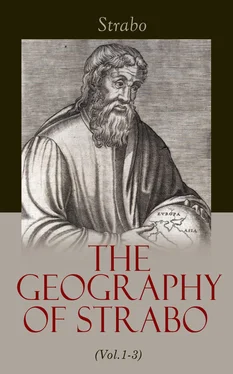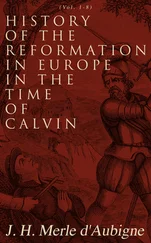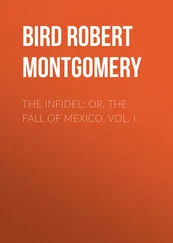Strabo - The Geography of Strabo (Vol.1-3)
Здесь есть возможность читать онлайн «Strabo - The Geography of Strabo (Vol.1-3)» — ознакомительный отрывок электронной книги совершенно бесплатно, а после прочтения отрывка купить полную версию. В некоторых случаях можно слушать аудио, скачать через торрент в формате fb2 и присутствует краткое содержание. Жанр: unrecognised, на английском языке. Описание произведения, (предисловие) а так же отзывы посетителей доступны на портале библиотеки ЛибКат.
- Название:The Geography of Strabo (Vol.1-3)
- Автор:
- Жанр:
- Год:неизвестен
- ISBN:нет данных
- Рейтинг книги:3 / 5. Голосов: 1
-
Избранное:Добавить в избранное
- Отзывы:
-
Ваша оценка:
- 60
- 1
- 2
- 3
- 4
- 5
The Geography of Strabo (Vol.1-3): краткое содержание, описание и аннотация
Предлагаем к чтению аннотацию, описание, краткое содержание или предисловие (зависит от того, что написал сам автор книги «The Geography of Strabo (Vol.1-3)»). Если вы не нашли необходимую информацию о книге — напишите в комментариях, мы постараемся отыскать её.
The Geography of Strabo (Vol.1-3) — читать онлайн ознакомительный отрывок
Ниже представлен текст книги, разбитый по страницам. Система сохранения места последней прочитанной страницы, позволяет с удобством читать онлайн бесплатно книгу «The Geography of Strabo (Vol.1-3)», без необходимости каждый раз заново искать на чём Вы остановились. Поставьте закладку, и сможете в любой момент перейти на страницу, на которой закончили чтение.
Интервал:
Закладка:
26. We must now describe the countries which surround it; and here we will begin from the same point, whence we commenced our description of the sea itself.
Entering the Strait at the Pillars, Libya, as far as the river Nile, is on the right hand, and to the left, on the other side of the Strait, is Europe, as far as the Don. Asia bounds both these continents. We will commence with Europe, both because its figure is more varied, and also because it is the quarter most favourable to the mental and social ennoblement of man, and produces a greater portion of comforts than the other continents.
Now the whole of Europe is habitable with the exception of a small part, which cannot be dwelt in, on account of the severity of the cold, and which borders on the Hamaxœci, 866who dwell by the Don, Mæotis, and Dnieper. The wintry and mountainous parts of the habitable earth would seem to afford by nature but a miserable means of existence; nevertheless, by good management, places scarcely inhabited by any but robbers, may be got into condition. Thus the Greeks, though dwelling amidst rocks and mountains, live in comfort, owing to their economy in government and the arts, and all the other appliances of life. Thus too the Romans, after subduing numerous nations who were leading a savage life, either induced by the rockiness of their countries, or want of ports, or severity of the cold, or for other reasons scarcely habitable, have taught the arts of commerce to many who were formerly in total ignorance, and spread civilization amongst the most savage. Where the climate is equable and mild, nature herself does much towards the production of these advantages. As in such favoured regions every thing inclines to peace, so those which are sterile generate bravery and a disposition to war. These two races receive mutual advantages from each other, the one aiding by their arms, the other by their husbandry, arts, and institutions. Harm must result to both when failing to act in concert, but the advantage will lie on the side of those accustomed to arms, except in instances where they are overpowered by multitudes. This continent is very much favoured in this respect, being interspersed with plains and mountains, so that every where the foundations of husbandry, civilization, and hardihood lie side by side. The number of those who cultivate the arts of peace, is, however, the most numerous, which preponderance over the whole is mainly due to the influence of the government, first of the Greeks, and afterwards of the Macedonians and Romans.
Europe has thus within itself resources both for war [and peace]. It is amply supplied with warriors, and also with men fitted for the labours of agriculture, and the life of the towns. It is likewise distinguished for producing in perfection those fruits of the earth necessary to life, and all the useful metals. Perfumes and precious stones must be imported from abroad, but as far as the comfort of life is concerned, the want or the possession of these can make no difference. The country likewise abounds in cattle, while of wild beasts the number is but small. Such is the general nature of this continent.
27. We will now describe separately the various countries into which it is divided. The first of these on the west is Iberia, which resembles the hide of an ox [spread out]; the eastern portions, which correspond to the neck, adjoining the neighbouring country of Gaul. The two countries are divided on this side by the chain of mountains called the Pyrenees; on all its other sides it is surrounded by sea; on the south, as far as the Pillars, by Our Sea; and thence to the northern extremity of the Pyrenees by the Atlantic. The greatest length of this country is about 6000 stadia, its breadth 5000. 867
28. East of this is Keltica, which extends as far as the Rhine. Its northern side is washed by the entire of the British Channel, for this island lies opposite and parallel to it throughout, extending as much as 5000 stadia in length. Its eastern side is bounded by the river Rhine, whose stream runs parallel with the Pyrenees; and its southern side commencing from the Rhine, [is bounded] partly by the Alps, and partly by Our Sea; where what is called the Galatic Gulf 868runs in, and on this are situated the far-famed cities of Marseilles and Narbonne. Right opposite to the Gulf on the other side of the land, lies another Gulf, called by the same name, Galatic, 869looking towards the north and Britain. It is here that the breadth of Keltica is the narrowest, being contracted into an isthmus less than 3000 stadia, but more than 2000. Within this region there is a mountain ridge, named Mount Cemmenus, 870which runs nearly at right angles to the Pyrenees, and terminates in the central plains of Keltica. 871The Alps, which are a very lofty range of mountains, form a curved line, the convex side of which is turned towards the plains of Keltica, mentioned before, and Mount Cemmenus, and the concave towards Liguria 872and Italy.
The Alps are inhabited by numerous nations, but all Keltic with the exception of the Ligurians, and these, though of a different race, closely resemble them in their manner of life. They inhabit that portion of the Alps which is next the Apennines, and also a part of the Apennines themselves. This latter mountain ridge traverses the whole length of Italy from north to south, and terminates at the Strait of Sicily.
29. The first parts of Italy are the plains situated under the Alps, as far as the recess of the Adriatic and the neighbouring places. 873The parts beyond form a narrow and long slip, resembling a peninsula, traversed, as I have said, throughout its length by the Apennines; its length is 7000 stadia, but its breadth is very unequal. The seas which form the peninsula of Italy are, the Tyrrhenian, which commences from the Ligurian, the Ausonian, and the Adriatic. 874
30. After Italy and Keltica, the remainder of Europe extends towards the east, and is divided into two by the Danube. This river flows from west to east, and discharges itself into the Euxine Sea, leaving on its left the entire of Germany commencing from the Rhine, as well as the whole of the Getæ, the Tyrigetæ, the Bastarnæ, and the Sauromatæ, as far as the river Don, and the Lake Mæotis, 875on its right being the whole of Thrace and Illyria, 876and in fine the rest of Greece.
Fronting Europe lie the islands which we have mentioned. Without the Pillars, Gadeira, 877the Cassiterides, 878and the Britannic Isles. Within the Pillars are the Gymnesian Islands, 879the other little islands of the Phœnicians, 880the Marseillais, and the Ligurians; those fronting Italy as far as the islands of Æolus and Sicily, and the whole of those 881along Epirus and Greece, as far as Macedonia and the Thracian Chersonesus.
31. From the Don and the Mæotis 882commences [Asia] on this side the Taurus; beyond these is [Asia] beyond the Taurus. For since this continent is divided into two by the chain of the Taurus, which extends from the extremities of Pamphylia to the shores of the Eastern Sea, 883inhabited by the Indians and neighbouring Scythians, the Greeks naturally called that part of the continent situated north of these mountains [Asia] on this side the Taurus, and that on the south [Asia] beyond the Taurus. Consequently the parts adjacent to the Mæotis and Don are on this side the Taurus. The first of these is the territory between the Caspian Sea and the Euxine, bounded on one side 884by the Don, the Exterior Ocean, 885and the Sea of Hyrcania; on the other 886by the Isthmus where it is narrowest from the recess of the Euxine to the Caspian.
Secondly, but still on this side the Taurus, are the countries above the Sea of Hyrcania as far as the Indians and Scythians, who dwell along the said sea 887and Mount Imaus. These countries are possessed on the one side by the Mæotæ, 888and the people dwelling between the Sea of Hyrcania and the Euxine as far as the Caucasus, the Iberians 889and Albanians, 890viz. the Sauromatians, Scythians, 891Achæans, Zygi, and Heniochi: on the other side beyond the Sea of Hyrcania, 892by the Scythians, 893Hyrcanians, Parthians, Bactrians, Sogdians, and the other nations of India farther towards the north. To the south, partly by the Sea of Hyrcania, and partly by the whole isthmus which separates this sea from the Euxine, is situated the greater part of Armenia, Colchis, 894the whole of Cappadocia 895as far as the Euxine, and the Tibaranic nations. 896Further [west] is the country designated on this side the Halys, 897containing on the side of the Euxine and Propontis the Paphlagonians, Bithynians, Mysians, and Phrygia on the Hellespont, which comprehends the Troad; and on the side of the Ægæan and adjacent seas Æolia, Ionia, Caria, and Lycia. Inland is the Phrygia which contains that portion of Gallo-Græcia styled Galatia, Phrygia Epictetus, 898the Lycaonians, and the Lydians.
Читать дальшеИнтервал:
Закладка:
Похожие книги на «The Geography of Strabo (Vol.1-3)»
Представляем Вашему вниманию похожие книги на «The Geography of Strabo (Vol.1-3)» списком для выбора. Мы отобрали схожую по названию и смыслу литературу в надежде предоставить читателям больше вариантов отыскать новые, интересные, ещё непрочитанные произведения.
Обсуждение, отзывы о книге «The Geography of Strabo (Vol.1-3)» и просто собственные мнения читателей. Оставьте ваши комментарии, напишите, что Вы думаете о произведении, его смысле или главных героях. Укажите что конкретно понравилось, а что нет, и почему Вы так считаете.












![Anne Blunt - A Pilgrimage to Nejd, the Cradle of the Arab Race. Vol. 2 [of 2]](/books/750183/anne-blunt-a-pilgrimage-to-nejd-the-cradle-of-the-thumb.webp)